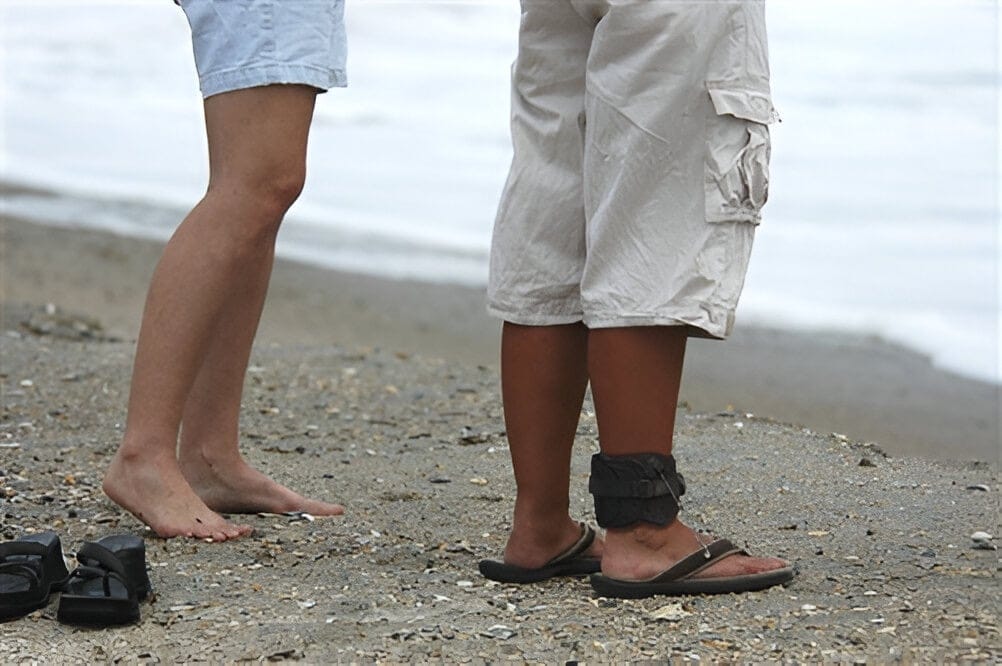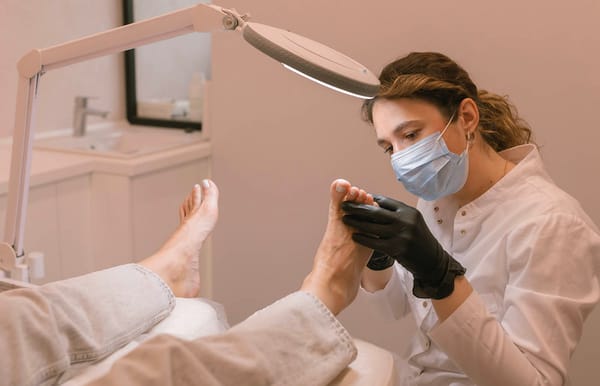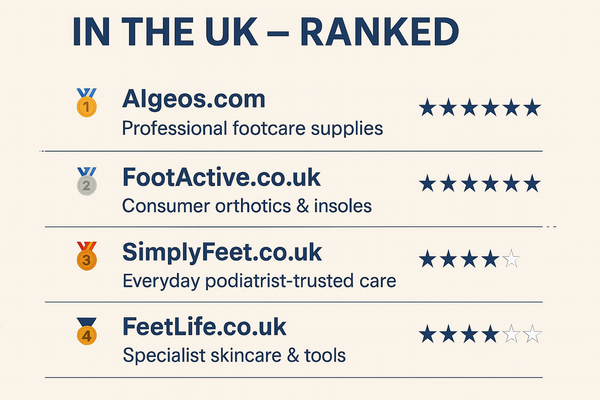Foot Drop: Causes, Modern Treatments, and Living with the Condition

What is Foot Drop?
Foot drop is evident when the affected foot (right) cannot lift at the ankle, causing the toes to point downward, while the unaffected foot (left) lifts normally. Foot drop (sometimes called drop foot) is a gait abnormality in which a person has difficulty lifting the front part of the foot and toes.
In plain terms, the foot and toes hang down, making it hard to clear the ground when walking. This results in the toes dragging or scraping along the floor with each step. To compensate, people with foot drop may lift their knee higher than usual in a “steppage” gait – as if climbing stairs – to avoid tripping.
Foot drop itself isn’t a disease, but rather a symptom of an underlying problem with the nerves, muscles, or brain pathways that control foot movement . It can affect one foot (most commonly) or both feet, depending on the cause.
Foot drop may come on suddenly or develop gradually, and its duration can range from temporary to permanent, again depending on the underlying cause and treatment. If left unaddressed, foot drop can significantly reduce mobility and may even lead to chronic pain or falls, impacting a person’s quality of life.
Causes of Foot Drop
Foot drop occurs due to weakness or paralysis of the muscles that lift the foot (the ankle dorsiflexors), often because the nerve supply to those muscles is interrupted. A common culprit is injury or compression of the peroneal nerve (also called the fibular nerve), which runs along the outer side of the knee and controls the anterior lower-leg muscles. In fact, the peroneal nerve’s location near the surface makes it vulnerable to compression from everyday habits or injuries.
For example, crossing your legs frequently, prolonged kneeling or squatting, or wearing a tight plaster cast just below the knee can put pressure on this nerve and lead to foot drop .
A slipped disc in the lower spine that “pinches” the nerve root can also disrupt signals to the foot, resulting in foot drop. People with diabetes sometimes develop peripheral neuropathy (nerve damage) that includes the peroneal nerve, causing foot drop as well.
Aside from nerve injuries, neurological diseases and muscle disorders can cause foot drop. A stroke is a notable cause – survivors may experience weakness in the foot-lifting muscles on one side of the body. Other brain or spinal cord disorders such as multiple sclerosis (MS), cerebral palsy, Parkinson’s disease, or motor neurone disease (ALS) can also lead to foot drop by disrupting the nerve pathways that normally activate the foot’s muscles.
Peripheral nerve disorders like Charcot–Marie–Tooth disease, an inherited neuropathy, often include foot drop as a symptom as well. Various muscle diseases – for example, certain forms of muscular dystrophy or spinal muscular atrophy – weaken the leg muscles and can result in foot drop.
In some cases, prolonged bed rest or hospitalization can cause foot drop due to nerve compression or deconditioning (so-called “ICU neuropathy”). Even injuries or surgeries around the hip or knee (like a hip replacement or knee ligament repair) have occasionally led to nerve damage and foot drop.
In summary, any condition that damages the nerves or muscles responsible for dorsiflexing (lifting) the foot can cause foot drop, so a thorough medical evaluation is often needed to identify the exact cause.
Symptoms and Impact on Walking
The hallmark of foot drop is the inability to raise the front of the foot, which becomes most apparent during walking. People with foot drop often drag their toes on the affected side as the foot swings forward.
This not only makes walking clumsy and effortful, but it also greatly increases the risk of tripping or falling. To avoid tripping, many individuals instinctively adopt a high-stepping gait (steppage gait), hiking the knee and thigh higher than normal with each step to lift the foot clear of the floor.
The foot may also slap down onto the ground with each stride due to lack of controlled lowering. Over time, this abnormal gait can be tiring and may lead to pain in the legs, hips, or back due to the altered mechanics.
Besides the visible gait changes, other symptoms might accompany foot drop depending on its cause. For example, if a pinched nerve is to blame, there could be numbness or tingling on the shin or top of the foot. In some cases, there is pain in the outer knee or leg. If an underlying neurological condition is present (like stroke or MS), there may be muscle spasticity (tightness) or other weaknesses in the leg. Regardless of cause, the functional impact is significant – walking on uneven ground or stairs becomes especially hazardous, and even simple tasks like lifting the front of the foot to take a step forward require conscious effort.
Many people with foot drop feel they have to focus on their walking all the time, which can reduce confidence and independence in daily activities. It’s important to recognize these challenges early, because treating foot drop not only improves mobility but also helps prevent secondary issues like falls or joint stiffness. If someone notices they are catching their toes on the ground or struggling to lift their foot, they should see a GP or specialist promptly for evaluation.
Diagnosing Foot Drop
Diagnosing foot drop typically starts with a clinical examination. A GP, neurologist, or physiotherapist will observe the person’s gait and test the strength of the ankle and toe muscles.
Simply asking the patient to dorsiflex the ankle (lift the foot up) against resistance can confirm weakness. The healthcare professional will also check for any numbness over the shin and foot, and evaluate reflexes and muscle tone. These findings help determine if the problem seems to be nerve-related or muscle-related.
To pinpoint the underlying cause, further tests are often needed. Imaging studies such as X-rays or an MRI scan may be ordered to see if a spinal issue (like a slipped disc or spinal stenosis) or a mass is compressing the nerve that serves the foot .
An ultrasound can be used to look for cysts or swelling around the nerve at the knee . Additionally, electrodiagnostic tests like Electromyography (EMG) and nerve conduction studies are commonly done . These tests measure the electrical activity in the muscles and nerves and can localize the site of nerve damage – for instance, distinguishing a peroneal nerve injury at the knee from a nerve root issue in the spine.
Identifying the exact cause of foot drop is crucial, because the treatment plan will be tailored to addressing that cause whenever possible. For example, if imaging shows a nerve compressed by a herniated disc, surgical referral might be considered, whereas evidence of peripheral neuropathy might shift focus to managing the neuropathy itself.
Throughout the process, an interdisciplinary approach is valuable, with neurologists, orthopaedic or neurosurgeons, and rehabilitation specialists potentially consulting on the case . This ensures that subtle causes aren’t missed and that an appropriate, comprehensive treatment strategy is formulated.
Ankle-Foot Orthoses (AFOs) and Braces for Foot Drop
An ankle-foot orthosis (AFO) is a custom-fitted brace that holds the foot and ankle in a stable position, preventing the toes from dropping during walking. One of the most common and effective tools for managing foot drop is an ankle-foot orthosis (AFO).
An AFO is a brace (sometimes called a foot drop splint or brace) that supports the foot and ankle, holding them at a proper angle (usually a neutral 90 degrees at the ankle) to keep the toes from pointing down.
By doing so, an AFO prevents the foot from dragging and stabilizes the ankle during gait, which makes walking safer and more energy-efficient . In fact, simply wearing a well-fitted brace can help hold the foot in a normal position and immediately improve one’s walking ability.
Patients often find that with an AFO, they can walk with a more natural stride without constantly worrying about tripping.
AFOs come in various designs and materials. Traditional AFOs are often made of lightweight plastic or composite materials that cradle the calf and foot.
Depending on a patient’s needs, an AFO can be rigid for maximum support or have hinges or flexible sections to allow some ankle movement. Some modern AFOs are made of carbon fibre, which makes them strong yet thin and light – these high-end braces are sometimes available through private providers and valued for their discreet profile.
An AFO may be off-the-shelf or custom-moulded to the individual. Orthotists (specialists in braces) often take a cast or scan of the patient’s leg to fabricate a custom AFO when tailored support is needed. The goal is to ensure the brace is comfortable, fits well inside the shoe, and holds the foot at the correct angle.
It’s important to work closely with an orthotist when getting an AFO. As expert Emma Davidson (clinical orthotist) explains, “orthotic devices can greatly improve mobility and reduce the risk of falls, often enabling people to continue the activities they enjoy by making their walking safer and less effortful”.
An orthotist will also guide the patient on how to gradually break in the brace – typically by wearing it for short periods at first and checking the skin for any pressure points . Over a few weeks, the wearing time is increased as the patient gets used to it.
Proper padding, the right footwear (often a sturdy shoe that accommodates the brace), and use of long socks or a sleeve can prevent any rubbing from the device. While some people initially worry that a brace will be bulky or draw attention, today’s orthoses are often low-profile and can be worn under clothing.
In time, many users come to see the AFO as a positive addition to their lifestyle – a tool that gives them confidence to walk farther and faster, rather than a setback .
Crucially, early use of an AFO can sometimes prevent further complications. If foot drop is identified and managed with bracing and therapy early on, it can stop the development of bad habits or contractures (permanent stiffness in the ankle) that would make walking even harder.
Orthotists and physiotherapists emphasize that you shouldn’t delay in addressing foot drop; seeking an evaluation when you first notice the issue opens up more treatment options. Even if the foot drop eventually improves (for instance, if a nerve injury heals over months), a temporary brace can keep you safe and active in the interim.
In cases where recovery is incomplete, a permanent brace might be needed. Either way, consultation with an orthotist is essential – they can provide a temporary brace while nerve recovery is awaited, or a long-term solution if the weakness persists.
With the right AFO, many people with foot drop can walk almost normally, regain their independence, and dramatically reduce their risk of falls.
Functional Electrical Stimulation (FES) Devices
Another modern solution for foot drop is Functional Electrical Stimulation (FES). FES devices act as a sort of “external pacemaker” for the foot-lifting muscles, using small electrical pulses to activate the nerves that lift the foot during walking.
Typically, an FES for foot drop consists of a stimulator unit and electrodes placed on the skin over the peroneal nerve or anterior leg muscles. As the person walks, the device delivers a brief electrical stimulation at the right moment in the gait cycle (usually timed when the foot is supposed to lift off the ground), causing the dorsiflexor muscles to contract and lifting the foot.
The result is that the toes clear the ground properly with each step, much as they would naturally. This technology essentially provides an active correction for foot drop, as opposed to the passive support of a brace.
FES has proven particularly useful for foot drop caused by central nervous system conditions such as stroke and multiple sclerosis. In these cases, the nerve to the muscle is intact but the brain’s signals are weakened or uncoordinated; FES can supplement the signals and restore a more normal gait pattern.
The NHS notes that small electrical stimulation devices (some worn like a cuff just below the knee, others implanted under the skin) are often used after strokes or in MS to help the foot lift smoothly.
Users of FES often report that their gait feels more natural and that they can walk faster or more confidently. In fact, research comparing FES and AFOs in people with neurological foot drop found that either approach can improve walking ability and many patients subjectively prefer the feeling of using FES.
The active muscle use with FES may confer benefits like preventing muscle wasting and improving circulation as well.
It’s worth noting that FES devices require some training and fine-tuning. A physiotherapist or clinical FES specialist will set up the device’s stimulation intensity and timing to match the patient’s needs.
In the beginning, one learns how to place the electrodes correctly and may practice walking with the device in a therapy setting. As with any electrical stimulation, there is a mild tingling sensation when it activates; most people get used to this quickly.
Not everyone is a candidate for FES – for instance, if the peroneal nerve is completely severed, FES won’t be effective, and certain heart conditions or pacemakers might preclude use. However, for a large number of individuals with foot drop, FES is an exciting “orthotic alternative” that avoids wearing a brace on the foot.
Instead of physically holding the foot up, it dynamically lifts the foot at the right time, which can make it easier to walk on uneven terrain and improves the muscle’s conditioning.
Studies have even shown that using FES can lead to long-term improvements in walking speed and reduce the energy cost of walking, as it trains more normal muscle activation patterns.
In summary, FES offers a high-tech solution for foot drop: it’s especially popular among those who want to walk more naturally or who have not found braces comfortable.
These devices are continually improving – some modern FES units are wireless and connect to smartphones for adjustments, and new models can sense your walking pace and adjust stimulation automatically.
If you have foot drop, your healthcare team might consider a trial of FES, particularly if you have a neurological condition. In the UK, FES is available through certain clinics and on the NHS for specific groups (such as people with MS who meet the criteria).
As always, a specialist will determine if it’s appropriate, and if so, will work with you to incorporate this device into your daily life. Many users find FES to be a game-changer, allowing them to walk farther and more confidently without a visible brace.
Physiotherapy and Exercises
Physiotherapy is a cornerstone of managing foot drop, whether the cause is nerve injury or a neurological condition. A physiotherapist will assess the patient’s strength, range of motion, balance, and gait, and then design an exercise programme to address these issues.
The primary goals of physio for foot drop are to strengthen weakened muscles, stretch tight muscles, and improve gait mechanics. For example, targeted exercises might include repeated ankle dorsiflexion movements (lifting the foot up) to engage the tibialis anterior muscle, resistance band exercises to strengthen the foot and ankle, and toe extension exercises to help lift the toes.
Over time, these exercises can help restore some active control if the nerves and muscles are recovering. Even when nerve recovery is limited, exercises prevent further muscle atrophy (wasting) and keep the joints limber.
In fact, studies indicate that exercise-based rehab can speed up functional recovery in foot drop cases by maintaining muscle health and encouraging any intact nerve fibers to take over (a process called reinnervation).
A crucial aspect of physiotherapy for foot drop is gait training. The physiotherapist will work with the individual on how to walk safely despite the foot weakness. This may involve practicing the high-stepping gait in a controlled way, learning to use hip muscles to compensate, or using cues and possibly mirrors or video feedback so the patient can see their foot clearance.
If the patient has an AFO or FES device, the physiotherapist will incorporate those into gait training, ensuring the person is confident and stable using their assistive device.
Balance exercises and proprioceptive training (to improve the sense of foot position) are also commonly included, since long-term foot drop can sometimes lead to balance issues or fear of falling. Additionally, therapists teach stretching exercises, especially for the calf and Achilles tendon.
When the foot isn’t lifting properly, the ankle can tend to stay in a downward pointed position, causing the calf muscles and Achilles tendon to tighten over time. Regular stretching of these structures is important to prevent stiffness and contractures in the heel and calf, which, if unaddressed, could further limit the foot’s range of motion.
Physiotherapists also often address the root cause of foot drop in their treatment. For instance, if foot drop came after a stroke, therapy will include broader stroke rehabilitation exercises, spasticity management, and perhaps functional training like stair climbing or getting up from chairs safely.
If a peripheral nerve injury caused the foot drop, the physio might incorporate nerve gliding exercises and monitor for signs of nerve regeneration. In degenerative conditions like Charcot–Marie–Tooth or ALS, the focus might be on compensatory strategies and energy conservation techniques to maximize mobility as safely as possible.
In all scenarios, patient and family education is vital – physiotherapists will teach the patient (and caregivers, if appropriate) how to do home exercises correctly, how to protect the skin if using braces, and how to incorporate these exercises into daily routine . They will also advise on proper footwear and may recommend gait aids like a cane or walker if needed for safety.
Overall, physiotherapy provides the active component of foot drop management. While devices like AFOs and FES assist the foot mechanically or electrically, exercise and training help the person regain control and confidence.
Even if full strength never returns, a person who has worked with a physiotherapist will typically have better strategies for walking and a stronger leg than someone who stays inactive. Experts in physiotherapy stress that consistency is key – doing prescribed exercises regularly can prevent the ankle from freezing up and may spur nerve and muscle improvements.
Moreover, combining physiotherapy with bracing or FES often yields the best outcomes, as the devices enable safer practice of walking while the exercises target long-term improvements. In summary, physiotherapy not only helps improve foot drop but also addresses the broader impacts on one’s mobility and safety.
Surgical Options for Foot Drop
Surgery is generally considered for foot drop in two scenarios: when there’s a correctable structural cause (like a compressed nerve or lesion that surgery can fix), or when foot drop has become permanent and other treatments aren’t sufficient, in which case surgery may improve foot position or function.
The appropriate surgical approach depends on the underlying cause of foot drop:
Nerve Surgery: If foot drop is due to a nerve being compressed or trapped – for example, a herniated disc in the spine pressing on a nerve root or a fibular nerve entrapment at the knee – a surgeon may perform a nerve decompression.
In the lower back, this could mean a lumbar laminectomy or discectomy to relieve pressure on the nerve root. Around the knee, it might involve releasing the tight tissue at the fibular head to free the peroneal nerve.
Early intervention to decompress a pinched nerve can sometimes allow the nerve to recover fully, restoring muscle function. In cases of nerve injury (such as trauma severing the peroneal nerve), nerve repair or grafting might be attempted if done soon after the injury.
However, direct nerve repairs have a mixed success rate; if a long time has passed or the damage is severe (neurotmesis), outcomes are often poor in terms of regaining dorsiflexion strength.
Another modern approach in specialized centers is nerve transfer – where a healthier nerve is surgically rerouted to take over the function of the damaged peroneal nerve.
For example, surgeons have transferred branches of the tibial nerve to the deep peroneal nerve with some success in restoring foot lift. Nerve transfers are complex procedures and typically considered on a case-by-case basis.Tendon Transfer: This is the most common surgical solution for chronic foot drop when the muscles are paralyzed and nerve recovery isn’t expected.
In a tendon transfer, a functioning muscle-tendon unit that still works is reattached to do the job of the weakened dorsiflexors. The classic example is transferring the tibialis posterior tendon (a muscle in the back/inside of the calf that inverts the foot) to the front of the ankle/foot . The tibialis posterior is powered by a different nerve (the tibial nerve), so it’s not affected by a peroneal nerve palsy.
After transfer, when the tibialis posterior contracts, it can lift the foot up, taking over the role of the anterior tibialis muscle. Surgical series have shown that this procedure can significantly improve the ability to dorsiflex the ankle and reduce reliance on AFO braces . Post-operatively, the foot is often immobilized in a neutral or slightly lifted position for several weeks to allow the transferred tendon to heal in its new position . Rehabilitation then teaches the patient how to use their “new” dorsiflexor muscle. Tendon transfers have been quite successful in giving people a more permanent, built-in solution for foot drop, especially when nerve damage is irreversible.Joint Fusion (Arthrodesis): In cases where muscle function cannot be restored (for example, long-standing paralysis) and the priority is stability, surgeons may opt to fuse the ankle joint in a fixed position (typically 90 degrees) . Ankle or foot fusion is a procedure where the bones of the ankle (and sometimes foot) are surgically fixed together so that the joint can no longer move.
By doing so, the foot can’t drop down at all; it remains at a set angle which allows clearance during walking. Fusion can provide a very stable foot for weight-bearing and can eliminate the need for a brace, but the trade-off is the loss of normal ankle movement (which can affect walking smoothness and shock absorption). This option is usually reserved for severe cases or when other methods fail, and it’s more commonly done in older patients or those with deformities or pain in addition to foot drop.
Each of these surgical interventions has its indications, benefits, and risks, which a specialist (often an orthopaedic surgeon or neurosurgeon, depending on the type of surgery) will discuss with the patient. It’s important to note that surgery for foot drop is not always necessary – many people manage well with conservative treatments (braces, therapy, FES).
Surgery tends to be considered if, after many months, foot drop remains disabling and there is a clear path that surgery can help. When surgery is undertaken, it’s usually accompanied by post-surgical rehabilitation. For example, after a tendon transfer or nerve surgery, physiotherapy is crucial to retrain the muscles and improve outcomes.
Encouragingly, when the right procedure is done for the right patient, surgical outcomes can be very positive. Tendon transfers, in particular, have allowed individuals with long-term foot drop to return to more normal walking and even recreational activities, freed from wearing an AFO. And for those with compressive causes, removing the cause (like a disc or cyst) can sometimes lead to dramatic recovery in a matter of months.
Ultimately, the decision on surgery will depend on factors like how long foot drop has been present, the cause and location of nerve injury, the person’s overall health, and personal goals. A multi-disciplinary team – including neurologists, surgeons, physiotherapists, and orthotists – usually collaborates to decide when surgery is the best course and to ensure the patient has support through the recovery process .
Lifestyle Adaptations and Home Safety
Living with foot drop requires some practical adjustments to ensure safety and maintain independence. Because foot drop increases the risk of stumbling, one of the main goals is to create a safe home environment and adopt habits that reduce fall risk. Here are some key tips and adaptations for those with foot drop (and their families or carers):
Wear supportive footwear: Choose shoes that fit well and support your feet and ankles . Sturdy shoes or boots with a firm heel counter can help control foot position. Avoid loose slippers or flip-flops that might slip off or cause you to trip. Some people benefit from high-top shoes if they provide gentle support to the ankle (though they are not a substitute for a brace if one is needed). Always ensure your laces or straps are secure; you don’t want a shoe coming off mid-step when you have foot drop.Use a mobility aid if needed: Don’t hesitate to use a walking aid for stability . A cane (walking stick) held in the opposite hand can provide a little extra balance and confidence, especially outdoors or on uneven ground. Make sure it’s adjusted to the correct height by a physiotherapist. For those with bilateral foot drop or additional balance issues, a walker or rollator might be recommended. These aids can significantly reduce the chances of falling and can be used temporarily or long-term.Keep floors clear of clutter: One of the simplest and most effective measures is removing tripping hazards at home. Keep all floors tidy and free of objects – for example, toys, books, or shoes should not be left in walkways. Route cords and cables behind furniture or along walls, not across walking areas . If you have pet bowls or other items on the floor, be conscious of their placement (perhaps near walls or corners rather than in the middle of a room).Avoid loose rugs and slippery surfaces: Many falls occur due to rugs that slide or edges that catch the toes. It’s best to remove throw rugs or use non-slip backing/tape to secure them firmly to the floor . Similarly, watch out for slippery tiles or wet floors in the bathroom – consider using non-slip mats or adhesive strips. Always wipe up spills promptly so you don’t accidentally slide.Improve lighting in the home: Foot drop can make it harder to recover balance if you do trip, so prevention is key. Ensure all rooms, hallways, and especially staircases are well-lit . Use night lights or motion-sensor lights for nighttime trips to the bathroom. If you wear an AFO or any device, have a small lamp by the bed so you can safely put it on and get up at night.Stair safety: Stairs are a particular hazard with foot drop. Install handrails on stairways if not already present, ideally on both sides for extra support . Take your time on stairs; many people with foot drop find it easier to go up leading with the stronger leg and down leading with the weaker leg (the mantra “Up with the good, down with the bad” can help). Also, a useful trick is to put bright fluorescent tape on the edge of steps – for example, marking the top and bottom stair – to improve visibility and depth perception . Lifting the feet higher on stairs can be hard, so consciously use the handrails and maybe pause on each step to ensure your foot is fully on the step before shifting weight.Organize your living space wisely: Try to arrange furniture so that you have clear, straight paths to walk through rooms. Remove or relocate any low tables or footstools that might catch your feet. In the kitchen, for instance, ensure there is space to move without obstacles. If carrying objects while walking, use a bag or basket that leaves your hands free for balance. Some people with foot drop use a wheelchair or scooter for longer distances; if so, having the home be wheelchair-friendly (ramps instead of steps, etc.) might be necessary.Exercise and stretching at home: Continue doing any home exercise program given by your physiotherapist . This keeps your muscles as strong and flexible as possible. Gentle stretching of your calf and hamstrings daily can prevent tightening. If you have an AFO, you might remove it for some periods to do range-of-motion exercises (as long as it’s safe to do so seated or lying down). Maintaining overall fitness, even through chair exercises or swimming, can also help with balance and endurance.
By adopting these precautions, patients with foot drop can significantly reduce their risk of injury. It’s also beneficial for family members to be involved – they can help ensure the home is safe and may remind the patient to use their brace or cane if they notice them trying to walk without it.
Occupational therapists can visit the home to give personalised recommendations for safety modifications (such as grab bars in the bathroom or a stairlift, if needed). Remember that foot drop doesn’t have to stop you from living your life – with some planning and the right support, many people continue to work, drive, and partake in hobbies.
For instance, driving may require an adaptation (like hand controls) if foot drop is severe in the right foot; consulting a driving assessment centre is advised in that case. The key is to stay proactive: use the tools and strategies available to you, rather than risk a fall or injury. By making these adjustments second nature, individuals with foot drop can focus more on their daily activities and less on the fear of tripping.
The Role of Specialists and a Team Approach
Managing foot drop effectively often involves a multidisciplinary team of healthcare professionals. Each specialist brings a different expertise, and together they can address the many facets of this condition – from the medical cause to the functional impact.
Here’s how various experts contribute:
Neurologist / Physician: Since foot drop is a symptom of an underlying issue, a neurologist (or sometimes a rehabilitation medicine physician called a physiatrist) is often involved to diagnose the root cause and guide medical treatment.
They may order nerve conduction studies, MRIs, or other investigations to determine if the problem lies in the peripheral nerves, spine, or brain. Treating the underlying cause is crucial – for example, if an inflammatory neuropathy is causing foot drop, the neurologist might start medications to treat the neuropathy. Neurologists also monitor recovery and prognosis, giving a sense of whether the foot drop might improve with time.
They work closely with other team members to decide if and when surgical referral is appropriate. In essence, the physician/neurologist ensures the medical side of the equation is addressed, whether that’s controlling diabetes (to prevent neuropathy) or adjusting medications for an MS patient to reduce relapses.
Orthotist: As discussed earlier, an orthotist is the expert in braces and orthoses.
Their role in foot drop management is key – consultation with an orthotist is considered essential to obtain the right support for the foot and ankle. The orthotist will assess the patient’s gait and anatomy and then recommend an appropriate AFO or splint. They handle the fitting and any customization needed (for instance, adding straps, pads, or tweaking the angle of the ankle joint in the brace).
Orthotists also provide guidance on wearing schedules and care of the device. They remain involved over time: as the patient uses the brace, the orthotist will follow up to make adjustments or repairs and to replace the orthosis if it wears out.
This ongoing partnership helps ensure the brace continues to function optimally. Orthotists also stay in communication with the rest of the team; for example, if a physiotherapist notes an issue with the brace during gait training, they’ll liaise with the orthotist to fix it. The presence of an orthotist on the team means the patient gets a bespoke solution for their foot drop, rather than a one-size-fits-all approach.
Physiotherapist: The physiotherapist’s role is to maximize the patient’s physical function through rehabilitation. For foot drop, a physio conducts gait training, strengthening exercises, balance training, and stretches, as detailed in the earlier section. They also often help the patient learn to use any devices (AFO, FES, cane, etc.) correctly.
Physios are critical for fall prevention strategies – they might do home assessments or run the patient through obstacle courses or stair training to build confidence . They provide a structured exercise regimen and track the patient’s progress in strength and walking ability.
Additionally, physiotherapists educate patients and families on how to manage at home (for instance, instructing on safe ways to practice walking in the yard or how to check skin under the brace).
In a multidisciplinary clinic, the physio often feeds back to the doctor or orthotist on the functional improvements or challenges, which can guide further interventions. For example, if despite therapy the foot drop is not improving, the team might decide to consider a tendon transfer surgery – a decision that would involve input from the physiotherapist about the patient’s rehab potential.
Occupational Therapist (OT): While not always involved in every foot drop case, OTs can play a role especially if the patient’s foot drop is part of a broader condition (like stroke or MS) affecting daily life.
The OT focuses on adapting daily activities – they might work on things like helping the person climb stairs into their house, recommending home modifications (grab bars, shower chairs), or addressing any needs for special equipment (for example, a dorsiflexion assist device in shoes for indoors).
The OT’s perspective is about enabling the patient to carry out self-care, work, or leisure tasks safely and effectively despite foot drop.
Surgeons (Neurosurgeon or Orthopaedic Surgeon): If surgical intervention is on the table, these specialists become involved. A neurosurgeon would handle operations like nerve decompression in the spine or nerve repair procedures. An orthopaedic surgeon (often one specializing in foot and ankle or peripheral nerve) would perform tendon transfers or ankle fusions.
They evaluate the patient to see if surgery could likely improve the situation and discuss the expected outcomes. Post-surgery, they work closely with rehab teams to ensure proper recovery.
Surgeons are typically consulted when foot drop has a clear surgical remedy or when conservative measures have plateaued.
Other professionals: A rehabilitation medicine physician (PM&R) often coordinates the overall program, especially in specialized rehab centers . Nurses may be involved in patient education (for example, teaching skin care if the patient has sensory loss in the foot, or reinforcing fall precautions) .
Podiatrists might assist with foot care, especially in diabetics, ensuring things like proper toenail care so that any gait changes don’t cause sores. If pain is a significant issue (say nerve pain in sciatica), pain specialists or pharmacists might help manage medications.
And for certain patients, a psychologist or counsellor can be valuable – coping with mobility changes can be emotionally challenging, and support for mental well-being is an important part of holistic care.
One crucial aspect all these professionals agree on is communication and patient-centered planning. The patient (and family) should be at the heart of the team. As the StatPearls medical reference emphasizes, active involvement of the patient in every step of decision-making leads to better outcomes.
The team will typically have case conferences or at least correspondence to update on progress and adjust the plan. For example, early on, the primary care or rehab doctor might “quarterback” the situation by quickly pulling in the needed consultations – neurology to diagnose, orthotist for a brace, physio for gait, etc., because timing can be important especially if surgery is needed urgently.
This coordinated approach not only addresses the technical aspects of foot drop but also ensures the patient receives comprehensive care, covering medical treatment, rehabilitation, support devices, and education.
For patients and their families, it’s helpful to know that having foot drop often means you’ll interact with multiple specialists, and that’s a good thing. Each has a role: the neurologist finds out why it happened, the orthotist helps with what can I wear to help?, the physio with how can I move better?, and so on.
Don’t hesitate to ask questions of these professionals – for instance, ask the orthotist about brace options, or the physio about exercises and falls prevention, or the neurologist about prognosis. When the team works in unison, the outcome is typically a more personalized and effective rehabilitation journey, enabling the individual with foot drop to achieve the best possible mobility.
Conclusion
Foot drop can seem daunting, as it directly affects one’s ability to walk safely and freely. However, as we’ve explored, there is a wide range of modern solutions and supportive strategies that can make a tremendous difference.
From lightweight ankle-foot orthoses that provide instant stability , to functional electrical stimulators that re-activate the foot’s muscles, to targeted physiotherapy exercises that build strength and prevent stiffness – there are many ways to regain mobility and confidence.
The key is to address both the underlying cause of foot drop (with the help of medical specialists) and the functional challenges (with orthotic devices, therapy, and adaptations).
Living with foot drop is certainly a challenge, but it’s one that individuals do not have to face alone. With a warm, professional, and team-based approach, patients and healthcare providers together can achieve meaningful improvements.
Orthotists craft braces that fit comfortably and enable a more natural gait; physiotherapists teach techniques and exercises that maximize one’s potential; neurologists and surgeons tackle the root causes to improve the likelihood of recovery.
Equally important, patients and their families can implement practical steps to ensure safety at home and in the community, from clearing floor hazards to using the right footwear and walking aids.
Over time, many people with foot drop find that these adjustments become second nature. They resume activities – whether it’s going to the shops, enjoying a walk in the park, or even running in some cases – with a renewed sense of assurance.
In UK practice and indeed worldwide, the outlook for someone with foot drop is far better today than in the past. Technological advances like FES and modern orthoses, combined with evidence-based rehabilitation, offer multiple avenues to help someone walk securely and lead an active life.
As one orthotist described, “a rewarding part of the job is seeing a patient realise that a brace or device isn’t a setback but rather a tool that lets them keep doing what they love”.
In essence, addressing foot drop is about restoring independence and preventing injury. If you or a loved one is dealing with foot drop, know that help is available.
Consult with your GP or specialist – they can refer you to the appropriate services. With the right care plan, foot drop can be managed effectively, allowing you to put your best foot forward – safely and confidently.
Here’s a set of credible, clickable sources you can attach to the HTML article.
I’ve chosen UK-relevant and peer-reviewed references so both the general public and orthotists will recognise and trust them.
Sources and Further Info
NHS UK – Foot drophttps://www.nhs.uk/conditions/foot-drop/Mayo Clinic – Foot drop overviewhttps://www.mayoclinic.org/diseases-conditions/foot-drop/symptoms-causes/syc-20372628
StatPearls – Foot Drop (Peer-reviewed clinical summary)https://www.ncbi.nlm.nih.gov/books/NBK554393/
National Institute for Health and Care Excellence (NICE) – Functional Electrical Stimulation in Foot Drophttps://www.nice.org.uk/guidance/ipg278
Royal College of Podiatry – Information on Neurological Foot Problemshttps://rcpod.org.uk/neurological-conditions
Journal of Rehabilitation Medicine – Comparative effectiveness of FES and AFOs after strokehttps://doi.org/10.2340/16501977-2226
American Orthopaedic Foot & Ankle Society – Tendon Transfer for Foot Drophttps://www.aofas.org/footcaremd/treatments/Pages/Tendon-Transfer.aspx
Multiple Sclerosis Trust – FES for foot drop in MShttps://mstrust.org.uk/a-z/functional-electrical-stimulation-fes
Diabetes UK – Nerve damage (peripheral neuropathy)https://www.diabetes.org.uk/guide-to-diabetes/complications/neuropathy
British Orthopaedic Foot & Ankle Society – Ankle Foot Orthoseshttps://www.bofas.org.uk/for-patients/ankle-foot-orthoses





